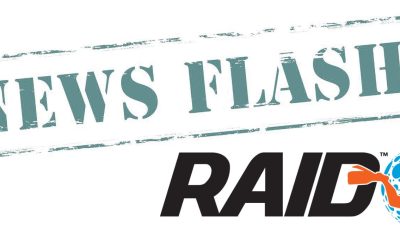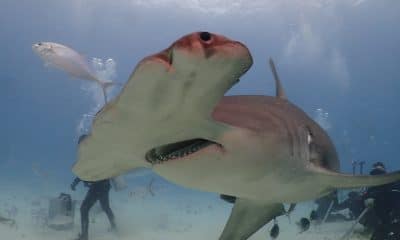News
Paul Toomer: Wreck Head
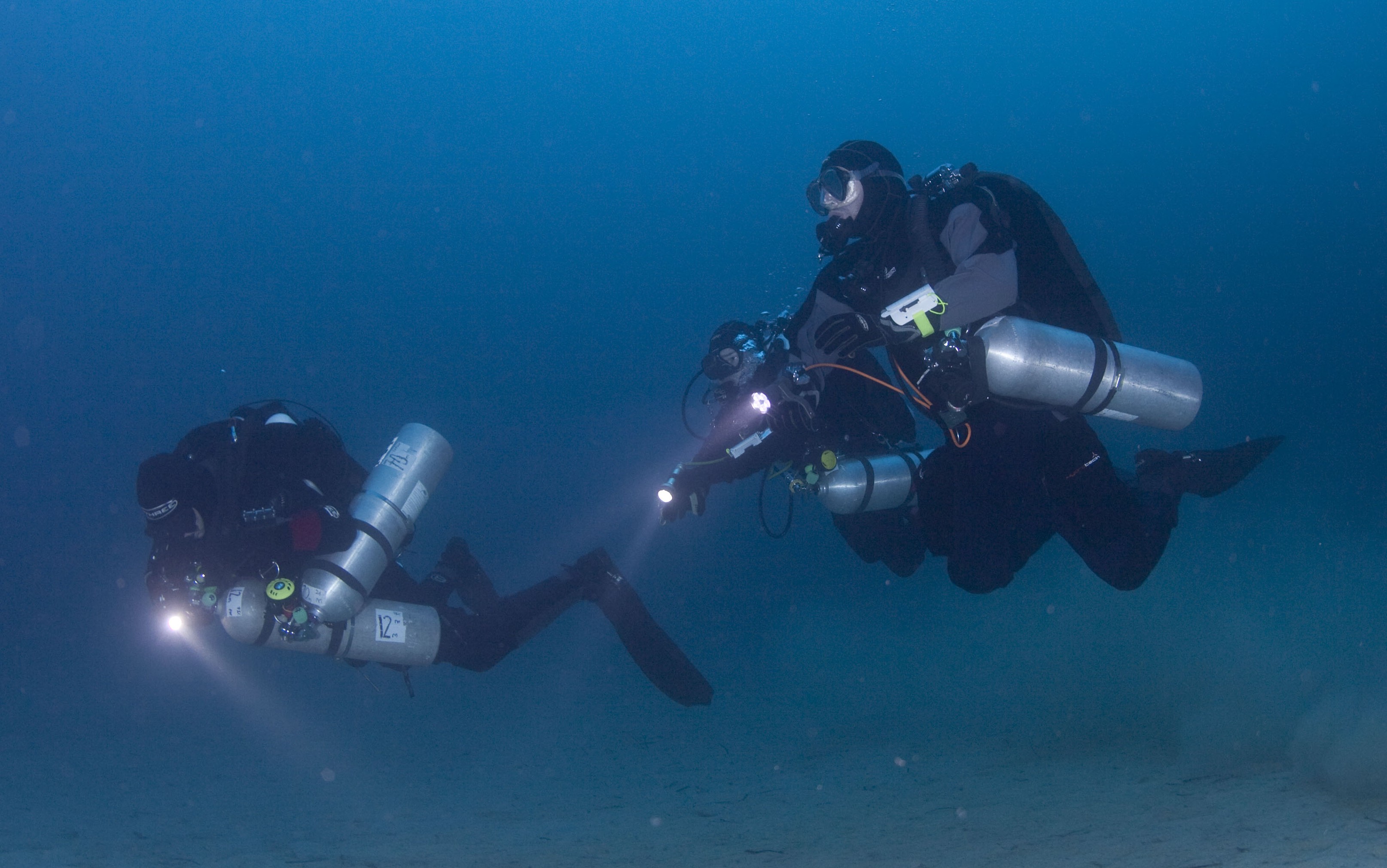
Part 7 – Backup Lights
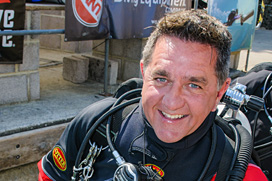 In the last ‘Wreck Head’ I started my discussion on primary lights with a little story about God’s primary light, the sun. Of course it has a cycle that it goes through and after around 12 or so hours in our sky it goes down. We are then plunged into darkness and before house and street lighting we all walked around banging into things and each other. Some of us fell down big holes or walked into bear caves and were eaten alive!!!
In the last ‘Wreck Head’ I started my discussion on primary lights with a little story about God’s primary light, the sun. Of course it has a cycle that it goes through and after around 12 or so hours in our sky it goes down. We are then plunged into darkness and before house and street lighting we all walked around banging into things and each other. Some of us fell down big holes or walked into bear caves and were eaten alive!!!
No, No, No… what utter rubbish. God in his infinite wisdom designed his own backup light so that we could all be safe while he put the sun on a trickle charger overnight. His backup light is the moon of course. Which funny enough is not made of cheese as previously theorised.
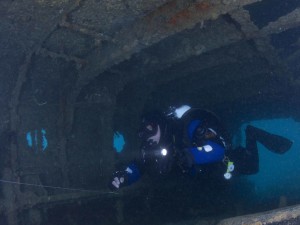 It does not take a rocket scientist (no pun intended) to work out why a backup light system would be a good thing to carry on all penetration dives. Loss of lighting in overhead environments has, unfortunately, been the cause of the untimely demise of a fair few divers. The really sad thing is it’s so easy to setup a backup system. What we want is a backup system that is pretty dependable and easy to use. And divers can’t even blame cost on not having lights anymore as the manufacturers have released backup lights to suit all pockets without jeopardising safety.
It does not take a rocket scientist (no pun intended) to work out why a backup light system would be a good thing to carry on all penetration dives. Loss of lighting in overhead environments has, unfortunately, been the cause of the untimely demise of a fair few divers. The really sad thing is it’s so easy to setup a backup system. What we want is a backup system that is pretty dependable and easy to use. And divers can’t even blame cost on not having lights anymore as the manufacturers have released backup lights to suit all pockets without jeopardising safety.
In this ‘Wreck Head’ we have a look at the design, reasoning behind, and the placement of backup light systems for overhead environment diving.
The most important thing I want from my backup light is… well, light!
Now this sounds daft but look at The Big Guy for example, he made loads of backup lights for us, they are called stars, but you can hardly bask in their light can you? So when I pick a light I want it to project a decent amount of light. I do not need it to be as powerful as my primary light in any way shape or form. I just need to be able to see my guideline, my directional markers, potential entanglement, abrasion hazards and of course the exit which is of paramount importance.
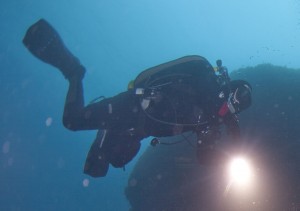 With this in mind, it means we can downscale the size of the backup light. We do not need anything complex and it does not need to be the size of a Winnebago. By downscaling we get pros and cons. The pros are, we can stow the light really easily. Therefore it can be placed in an area where it is super streamlined, easily accessible and easily restowed. The cons are that unless you place it properly it can be a pain to find and if the light is not set up or placed properly it can be easily dropped and lost. Of course the final issue is that small lights have shorter burn times… or do they?
With this in mind, it means we can downscale the size of the backup light. We do not need anything complex and it does not need to be the size of a Winnebago. By downscaling we get pros and cons. The pros are, we can stow the light really easily. Therefore it can be placed in an area where it is super streamlined, easily accessible and easily restowed. The cons are that unless you place it properly it can be a pain to find and if the light is not set up or placed properly it can be easily dropped and lost. Of course the final issue is that small lights have shorter burn times… or do they?
Modern backup light systems use LED (Light-Emitting Diode) bulbs that emit a huge amount while using a relatively low amount of power. LED lights also have an extremely long life with the average LED lasting around ten to twenty thousand hours. In today’s world, buying a backup light that is not LED is quite simply nuts. Hell, do any of the manufacturers make non LED lights?
The ideal backup light needs to be a thin long(ish) cylindrically shaped light with no handle on it. I prefer to have no switches either; I like lights that are turned on by screwing the light head in or out. The problem with having a light with a switch on is that sometimes switches don’t work. However, modern switches are much more reliable than they were just a few years ago.
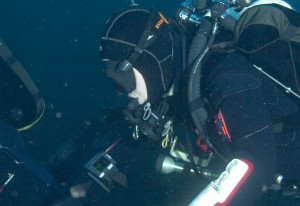 I like the long cylindrical shape as I can fix a single piston clip to the base of the light and have the light hang from my Chest D Ring on my harness. The light needs to be around the same diameter as the width of a piece of webbing. This allows us to secure the light to the webbing using bungee loops or preferably bicycle inner tubing threaded onto the harness. The light must not be too long as it will hang too far towards the diver’s waist making it very uncomfortable to wear. Also, if it is too long, accessing the light will be a lot more difficult.
I like the long cylindrical shape as I can fix a single piston clip to the base of the light and have the light hang from my Chest D Ring on my harness. The light needs to be around the same diameter as the width of a piece of webbing. This allows us to secure the light to the webbing using bungee loops or preferably bicycle inner tubing threaded onto the harness. The light must not be too long as it will hang too far towards the diver’s waist making it very uncomfortable to wear. Also, if it is too long, accessing the light will be a lot more difficult.
So, we hit the wreck with our primary, umbilical, lightsaber, monster of a light that will make those things at Wembley look like Christmas tree lights and a backup. Sorry, big mistake. We take two backup lights with us. Backup lights need to be trustworthy and reliable so the industry standard is to use non-rechargeable batteries rather than rechargeables.
The simplicity is that rechargeable batteries lose their charge quite quickly and sometimes don’t take on charge properly. Sometimes the batteries just die. With non-rechargeable batteries we open a new packet of factory made, one life only batteries, this minimises the chances of any of the above failures. But just to be double sure, we have a second light prepared in exactly the same manner. So if backup light one goes, we simply move to light two.
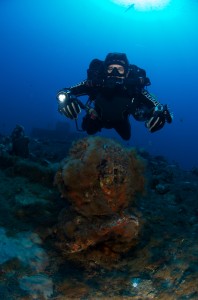 This also gives us a time advantage, as it should take an age to burn two lights out. The second light can also be given to a teammate in the event they have a VERY bad day out and lose all their lighting. My favourite reason for carrying that third light is that it can be tied into the guideline in the event of a lost buddy scenario. The small light ties easily into the line and the search diver can leave the beam of the light facing the exit in case the missing diver returns to the line. What a bloody brilliant bit of lateral thinking by the person that designed this technique.
This also gives us a time advantage, as it should take an age to burn two lights out. The second light can also be given to a teammate in the event they have a VERY bad day out and lose all their lighting. My favourite reason for carrying that third light is that it can be tied into the guideline in the event of a lost buddy scenario. The small light ties easily into the line and the search diver can leave the beam of the light facing the exit in case the missing diver returns to the line. What a bloody brilliant bit of lateral thinking by the person that designed this technique.
Using the backup light is really simple. Both lights are piston clipped to the chest D rings on the left and right sides of the harness. If one has to be used, the diver simply pulls the light free from the bungees or tubing, turns it on and aims it in the direction they want to go. NEVER unclip the light from the D ring – if you drop the light, it stays attached to the D ring and most importantly, YOU! Another great advantage of setting your backup light system like this is that if you have to work with both hands, you can let the light go and it will naturally shine down illuminating whatever you are working with.
And there you have it.
I hope you agree with me now that not carrying a backup light system is quite frankly mad! Simple, cheap, streamlined and easy to use. And let’s face it, they look über cool too!!!
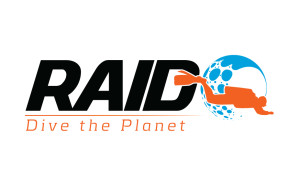 Paul is the Director of Training at RAID. To find out more about the courses that RAID offers, visit www.diveraid.com.
Paul is the Director of Training at RAID. To find out more about the courses that RAID offers, visit www.diveraid.com.
Gear News
Scubapro Free Octopus Promotion 2024

Free Octopus with every purchase of a SCUBAPRO regulator system
Just in time for the spring season, divers can save money with the FREE OCTOPUS SPRING PROMOTION! Until July 31st SCUBAPRO offers an Octopus for free
with every purchase of a regulator system!
Get a free S270 OCTOPUS with purchase of these combinations:
MK25 EVO or MK19 EVO with A700
MK25 EVO or MK19 EVO with S620Ti
MK25 EVO or MK19 EVO with D420
MK25 EVO Din mit S620Ti-X
Get a free R105 OCTOPUS with purchase of the following combinations:
MK25 EVO or MK19 EVO with G260
MK25 EVO or MK17 EVO with S600
SCUBAPRO offers a 30-year first owner warranty on all regulators, with a revision period of two years or 100 dives. All SCUBAPRO regulators are of course certified according to the new European test standard EN250-2014.
Available at participating SCUBAPRO dealers. Promotion may not be available in all regions. Find an authorized SCUBAPRO Dealer at scubapro.com.
More information available on www.scubapro.com.
Blogs
Northern Red Sea Reefs and Wrecks Trip Report, Part 3: The Mighty Thistlegorm

Jake Davies boards Ghazala Explorer for an unforgettable Red Sea diving experience…
Overnight, the wind picked up, making the planned morning dive a bit bumpy on the Zodiacs to the drop point on Thomas Reef. There, we would dive along the reef before descending through the canyon and then passing under the arch before ascending the wall with a gentle drift. The site provided great encounters with more pelagic species, including shoals of large barracuda, tuna, and bigeye trevally.
Once back on the boat, it was time to get everything tied down again as we would head back south. This time, with the wind behind us, heading to Ras Mohammed to dive Jackfish Alley for another great gentle drift wall dive before then heading up the coast towards the Gulf of Suez to moor up at the wreck of the Thistlegorm. This being the highlight wreck dive of the trip and for many onboard, including myself, it was the first time diving this iconic wreck. I had heard so much about the wreck from friends, and globally, this is a must on any diver’s list. Fortunately for us, there was only one other boat at the site, which was a rarity. A great briefing was delivered by Ahmed, who provided a detailed background about the wreck’s history along with all the required safety information as the currents and visibility at the site can be variable.

Kitting up, there was a lot of excitement on deck before entering the water and heading down the shoreline. Descending to the wreck, there was a light northerly current which reduced the visibility, making it feel more like the conditions that can be found off the Welsh coast. At 10m from the bottom, the outline of the wreck appeared as we reached the area of the wreck which had been bombed, as our mooring line was attached to part of the propeller shaft. Arriving on deck, instantly everywhere you looked there were many of the supplies which the ship was carrying, including Bren Carrier tanks and projectiles that instantly stood out.

We headed around the exterior, taking a look at the large propeller and guns mounted on deck before entering the wreck on the port side to take a look in the holds. It was incredible to see all the trucks, Norton 16H, and BSA motorcycles still perfectly stacked within, providing a real snapshot in time.

Overall, we had four dives on the Thistlegorm, where for all of the dives we were the only group in the water, and at times, there were just three of us on the whole wreck, which made it even more special, especially knowing that most days the wreck has hundreds of divers. Along with the history of the wreck, there was plenty of marine life on the wreck and around, from big green turtles to batfish, along with shoals of mackerel being hunted by trevally. Some unforgettable dives.

The final leg of the trip saw us cross back over the Suez Canal to the Gobal Islands where we planned to stay the night and do three dives at the Dolphin House for the potential of sharing the dive with dolphins. The site, which included a channel that was teeming with reef fish, especially large numbers of goatfish that swam in large shoals along the edge of the reef. These were nice relaxing dives to end the week. Unfortunately, the dolphins didn’t show up, which was okay as like all marine life they are difficult to predict and you can’t guarantee what’s going to be seen. With the last dive complete, we headed back to port for the final night where it was time to clean all the kit and pack before the departure flight the next day.

The whole week from start to finish on Ghazala Explorer was amazing; the boat had all the facilities you need for a comfortable week aboard. The crew were always there to help throughout the day and the chefs providing top quality food which was required after every dive. The itinerary providing some of the best diving with a nice mixture of wreck and reef dives. I would recommend the trip to anyone, whether it’s your first Red Sea liveaboard in the Red Sea or you’re revisiting. Hopefully, it’s not too long before I head back to explore more of the Red Sea onboard Ghazala Explorer.

To find out more about the Northern Red Sea reef and wrecks itineraries aboard Ghazala Explorer, or to book, contact Scuba Travel now:
Email: dive@scubatravel.com
Tel: +44 (0)1483 411590
Photos: Jake Davies / Avalon.Red
-

 News3 months ago
News3 months agoHone your underwater photography skills with Alphamarine Photography at Red Sea Diving Safari in March
-

 News3 months ago
News3 months agoCapturing Critters in Lembeh Underwater Photography Workshop 2024: Event Roundup
-

 Marine Life & Conservation Blogs2 months ago
Marine Life & Conservation Blogs2 months agoCreature Feature: Swell Sharks
-

 Blogs2 months ago
Blogs2 months agoMurex Resorts: Passport to Paradise!
-

 Blogs2 months ago
Blogs2 months agoDiver Discovering Whale Skeletons Beneath Ice Judged World’s Best Underwater Photograph
-

 Gear Reviews3 months ago
Gear Reviews3 months agoGear Review: Oceanic+ Dive Housing for iPhone
-

 Marine Life & Conservation2 months ago
Marine Life & Conservation2 months agoSave the Manatee Club launches brand new webcams at Silver Springs State Park, Florida
-

 Gear Reviews2 weeks ago
Gear Reviews2 weeks agoGEAR REVIEW – Revolutionising Diving Comfort: The Sharkskin T2 Chillproof Suit











